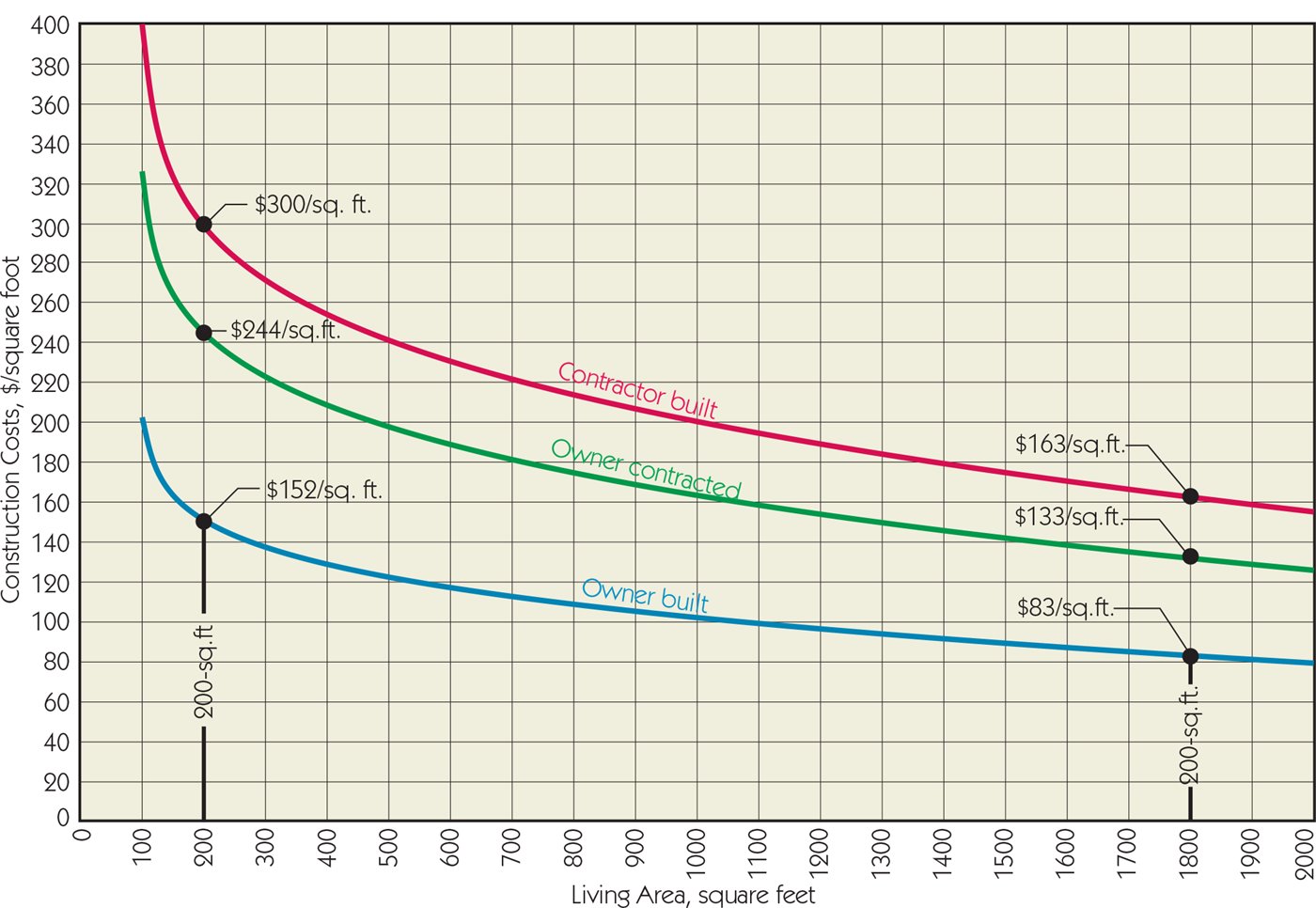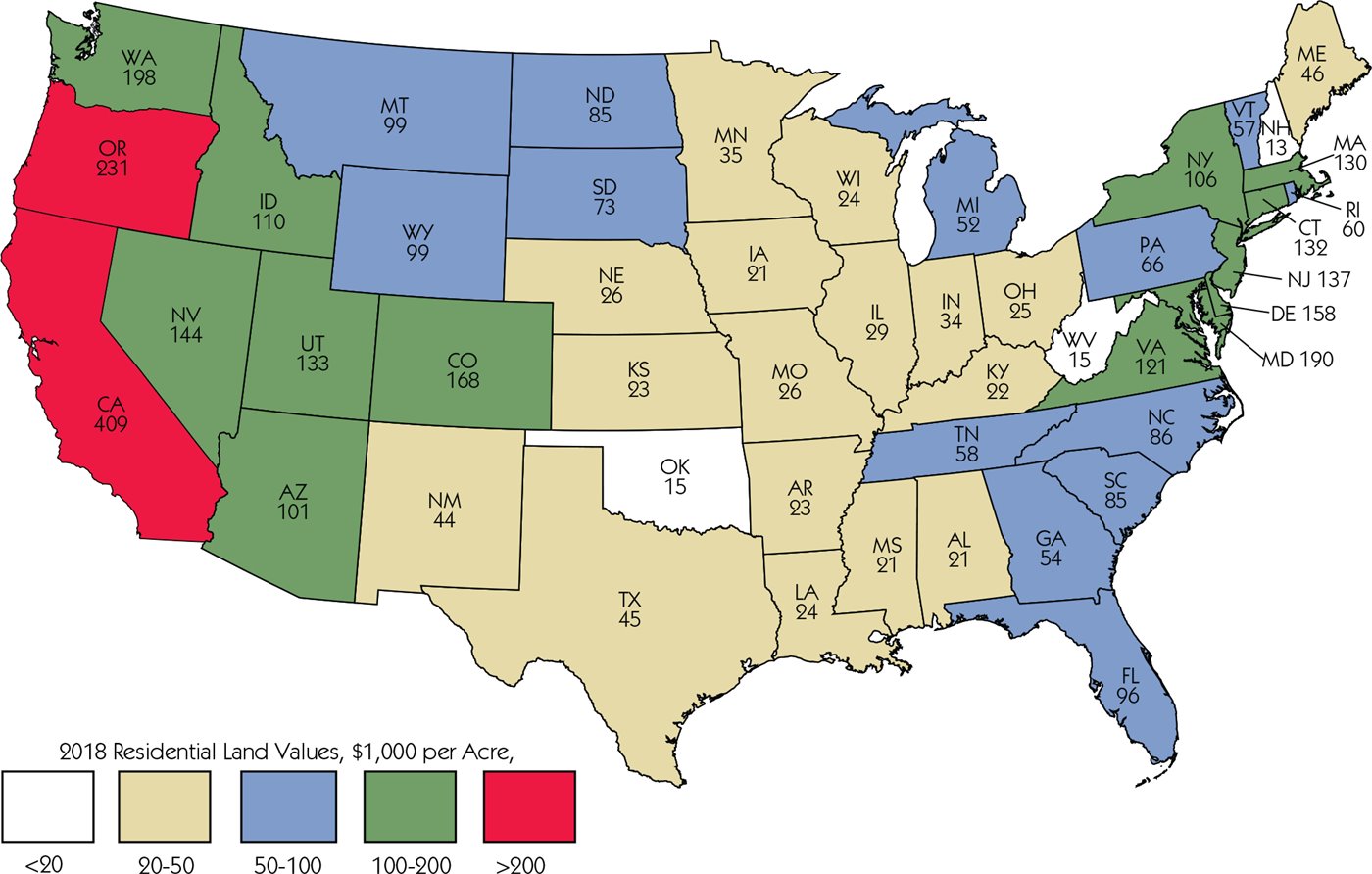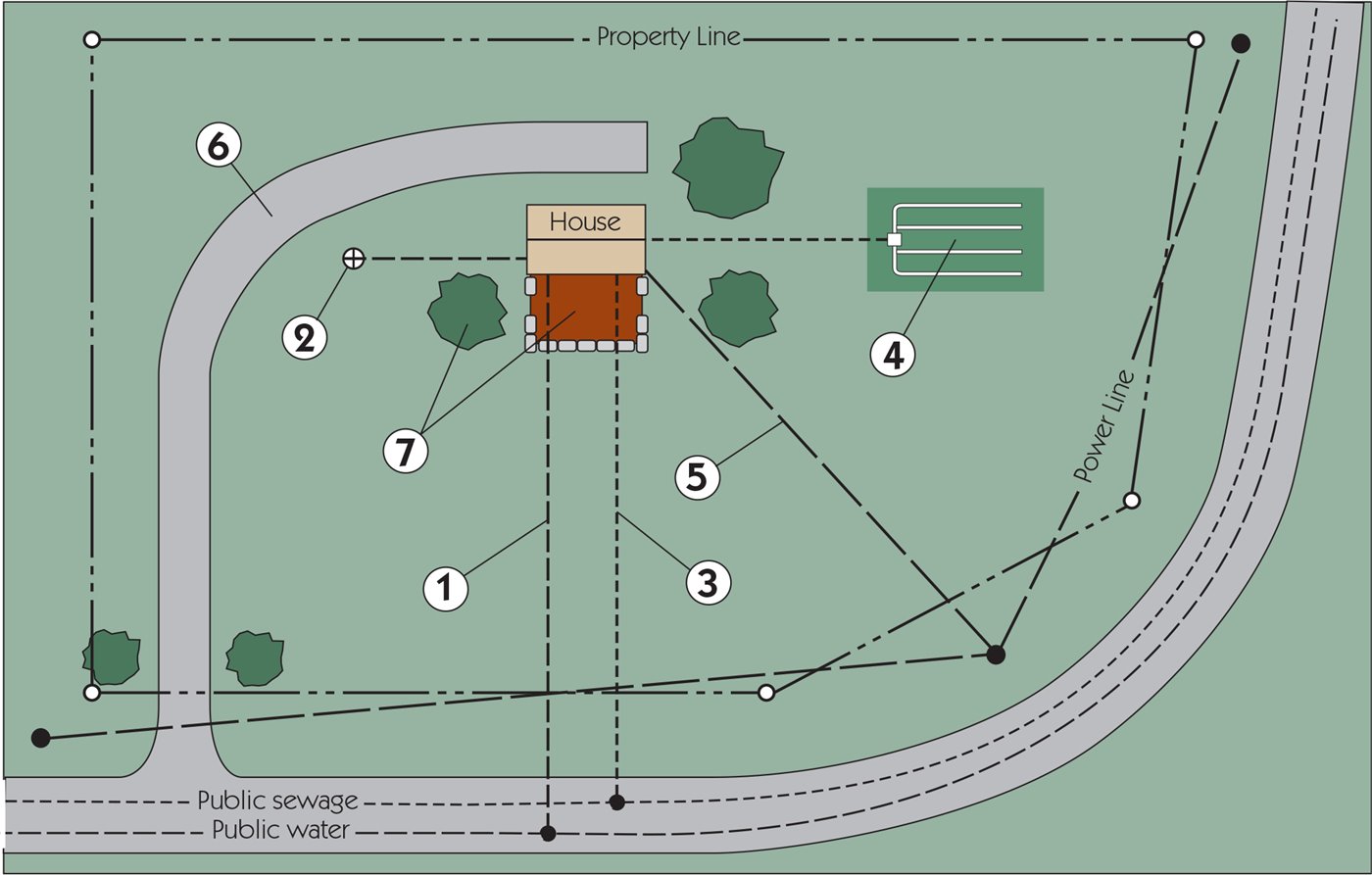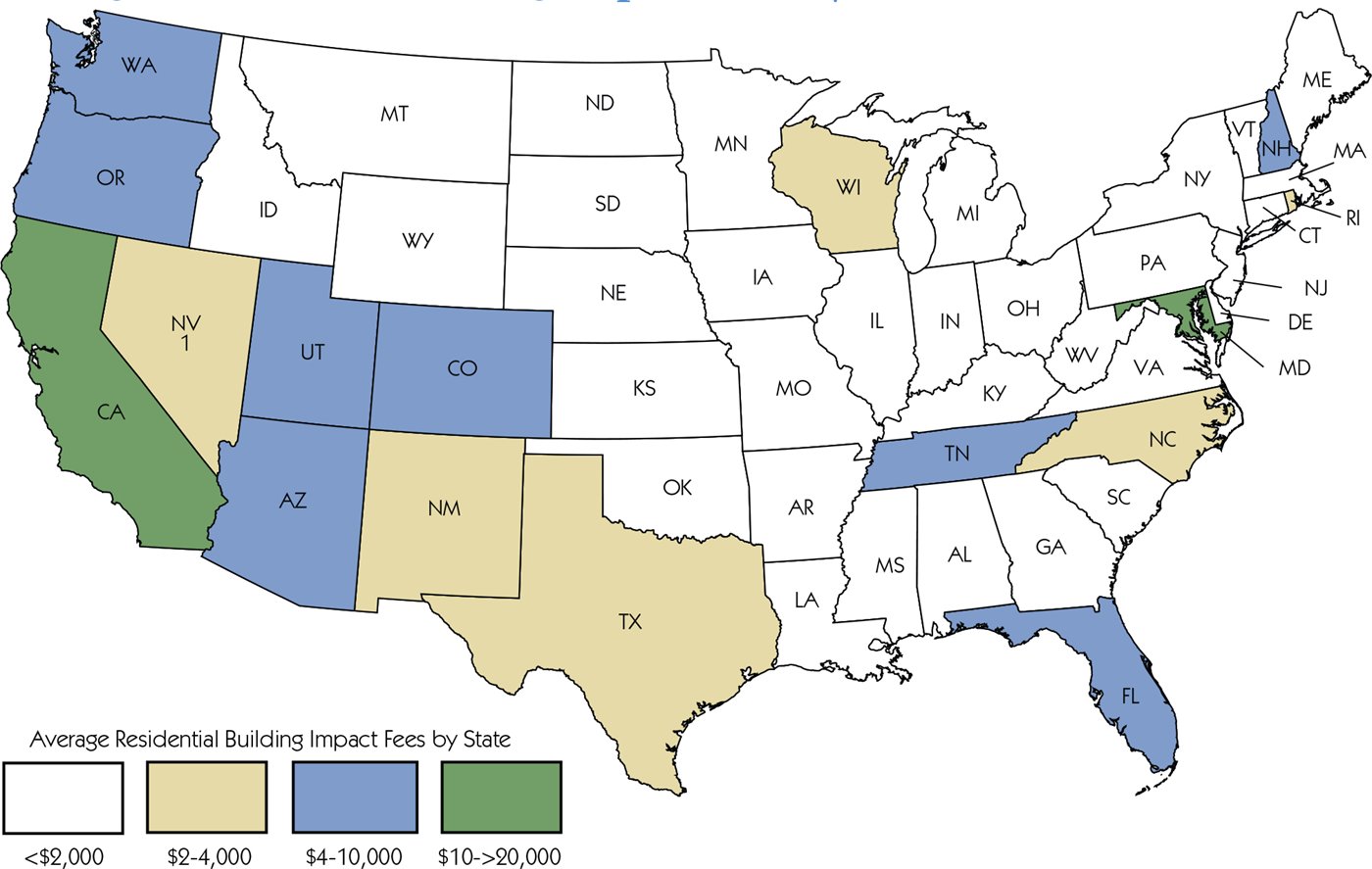
Полная версия
The Tiny House Handbook
The graphs demonstrate what should be intuitive: the smaller the house, the more expensive per square foot. The reason for this phenomenon is that kitchens, baths, heating and cooling systems, and so on are common to all homes, but are not strictly proportional to size.
The magnitude of the differences is seen in the two examples shown. The average contracted 200-sq.ft. house costs $300 per sq.ft., while the 1,800-sq.ft. home costs about half as much per sq.ft., $163.
Again, applying the savings from supplying labor, the owner-contractor (green curve) and the total do-it-yourselfer (blue curve) can reduce those numbers by approximately twenty and fifty percent.
Contracted vs Do-It-Yourself Costs/Sq.Ft. as a Function of Size
Total Construction Cost
Of course the bottom line when building or buying a home is not cost per square foot but total cost. Total cost is simply cost per square foot × total square feet. The graph below is the result of performing this multiplication on the curves on the previous page.
Using the same two example homes, 1,800 and 200 square feet, we get $293,400 and $60,000 for the fully contracted versions. For the total do-it-yourself versions of the same homes we project $149,400 and $30,400— plenty of incentive for the prospective small-home DIYer!
If $30,400 doesn’t align with what you have heard, seen on television, or read in a magazine, remember: the figures in these graphs represent average figures for average construction. The use of less expensive grades and recycled or donated materials and appliances can lower these costs substantially.
Contracted vs Do-It-Yourself Total Cost as a Function of Size
Big Added Cost: The Site
The cost figures in the previous charts are for the building alone, not including the site and site services. Unless your planned tiny home is on wheels and you plan an eternal road trip, or your home will be an “accessory dwelling unit” sharing the site with an existing home, sooner or later you will have to purchase or rent a site on which to place the structure.
The map below displays the extraordinary range of prices of land in dollars per acre, from about $15,000 in rural areas such as New Hampshire, West Virginia, and Oklahoma, to over $400,000 in sunny California.
The numbers are not prices per lot but prices per acre, so you have to multiply by the size of the lot. Minimum lot size is specified in zoning ordinances and usually varies by zone. In rural and very affluent areas minimum lot sizes can be three or more acres, while densely populated areas may be zoned ¼ acre minimum.
Prices also vary widely within states. Lots within metropolitan areas are much more expensive than those in less developed areas. Lesson: do your homework! Websites such as Zillow.com allow unlimited research on your computer or mobile device.
2018 Residential Building Site Costs, $1,000 per Acre
More Added Costs: Site Services
Site services are all those things added to a lot to make the building/lot combination habitable. If the lot is in a development it may already have most or all services already. If not, here are the things you may have to add (see illustration below):
1. Public Water. If a public water main runs in front of your lot, you will be required to connect to it for a fee.
2. Well. If public water is not available you will need to drill a well or haul water.
3. Public Sewage. If a public sewer line runs past your lot, you will be required to connect to it even if the lot contains a private system.
4. Septic System. Unless public sewage is available or you use a composting toilet to eliminate “black waste” you will need a septic tank and leach field or a holding tank.
5. Electric Service. Unless you go off grid with a solar system, you will connect to the power line. Extending the existing line more than one or two poles is extremely expensive.
6. Driveway. You will probably want a solid, low-maintenance driveway. A 3-inch-thick asphalt drive costs about $10 per sq.ft.
7. Landscaping. Grading for drainage, a layer of topsoil, and a few shade trees are the minimal starting point.
Building Site Services
Added Costs: Impact Fees?
Impact fees comprise a fairly recent addition to the cost of building a home. In areas experiencing rapid growth, counties, cities, and towns are having to improve and expand roads, extend water and sewer lines, expand water and sewage treatment plants, add fire stations, develop parks and recreational facilities, and build additional schools.
The map shows where impact fees are most often assessed and the average fees imposed per home. It is not surprising to see the most and the highest fees occurring in the western, southwestern, and southeastern states where the population growth rate is greatest.
Depending on the state, fees may be charged for any or all of these categories:
• Schools
• Roads
• Water
• Sewage
• Storm water drainage
• Police
• Fire
• Library
• Parks
Average Residential Building Impact Fees by State
4
DESIGN
Oh boy, let the fun begin!
When was the last time someone said to you, “Go ahead, pick anything you want.” Of course the understanding was not anything, but anything within reason—in your case within your budget. But, hey! You get to pick what you want, not what someone else thinks you should have.
Designing is the most fun part of creating your tiny house. It is also the most important because it can:
Конец ознакомительного фрагмента.
Текст предоставлен ООО «ЛитРес».
Прочитайте эту книгу целиком, купив полную легальную версию на ЛитРес.
Безопасно оплатить книгу можно банковской картой Visa, MasterCard, Maestro, со счета мобильного телефона, с платежного терминала, в салоне МТС или Связной, через PayPal, WebMoney, Яндекс.Деньги, QIWI Кошелек, бонусными картами или другим удобным Вам способом.

